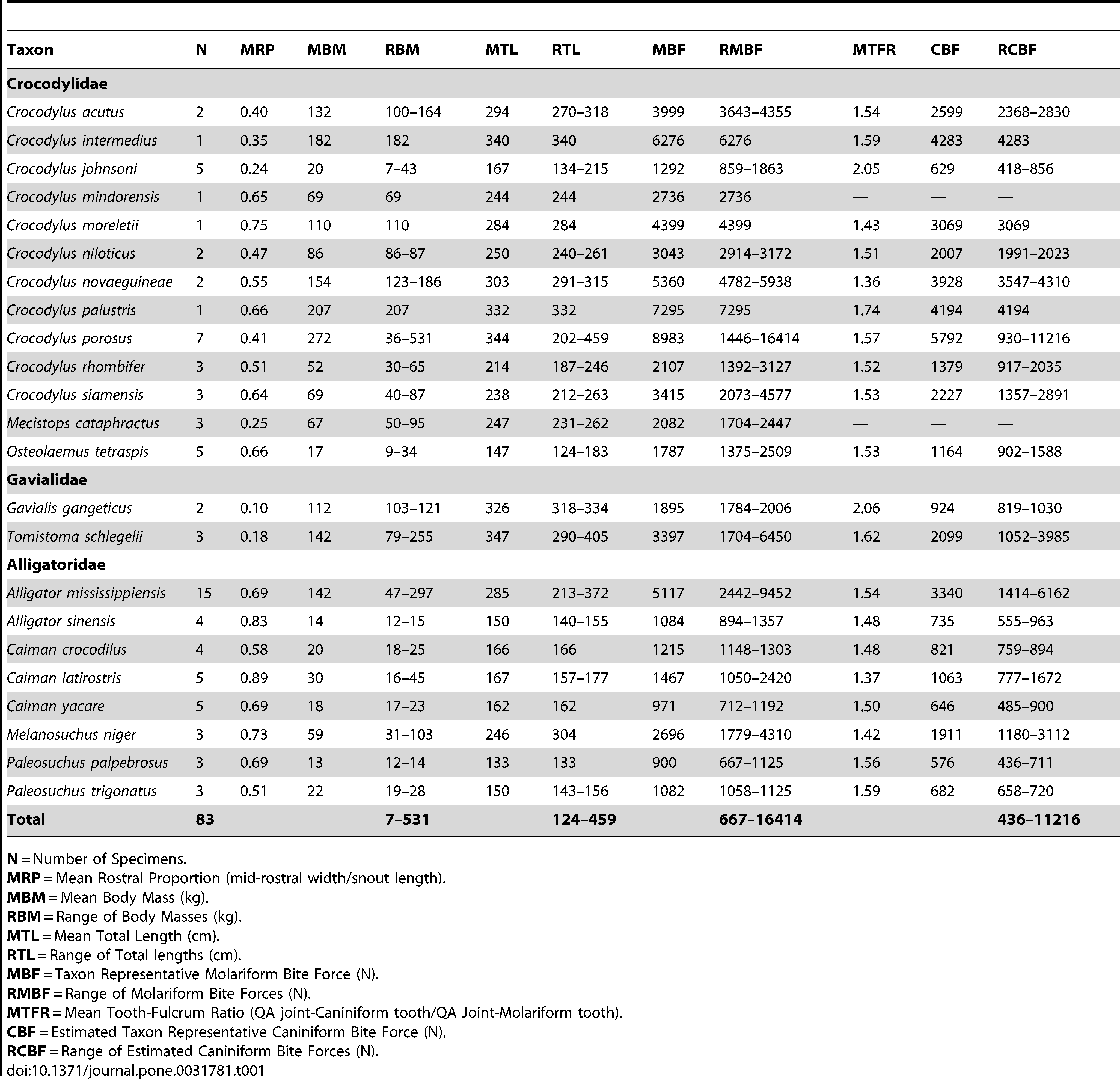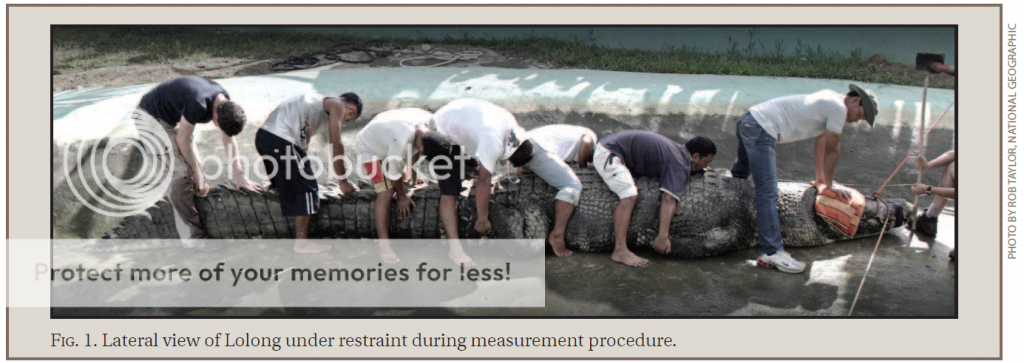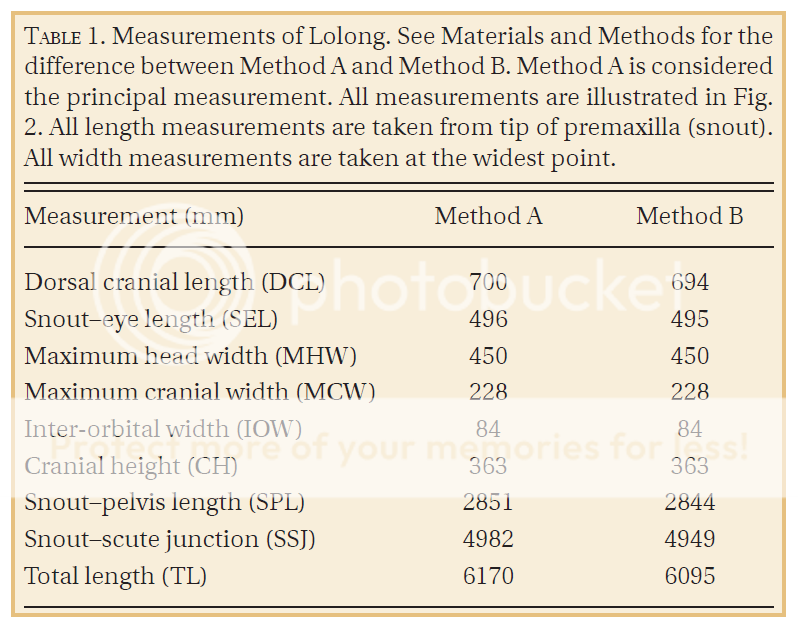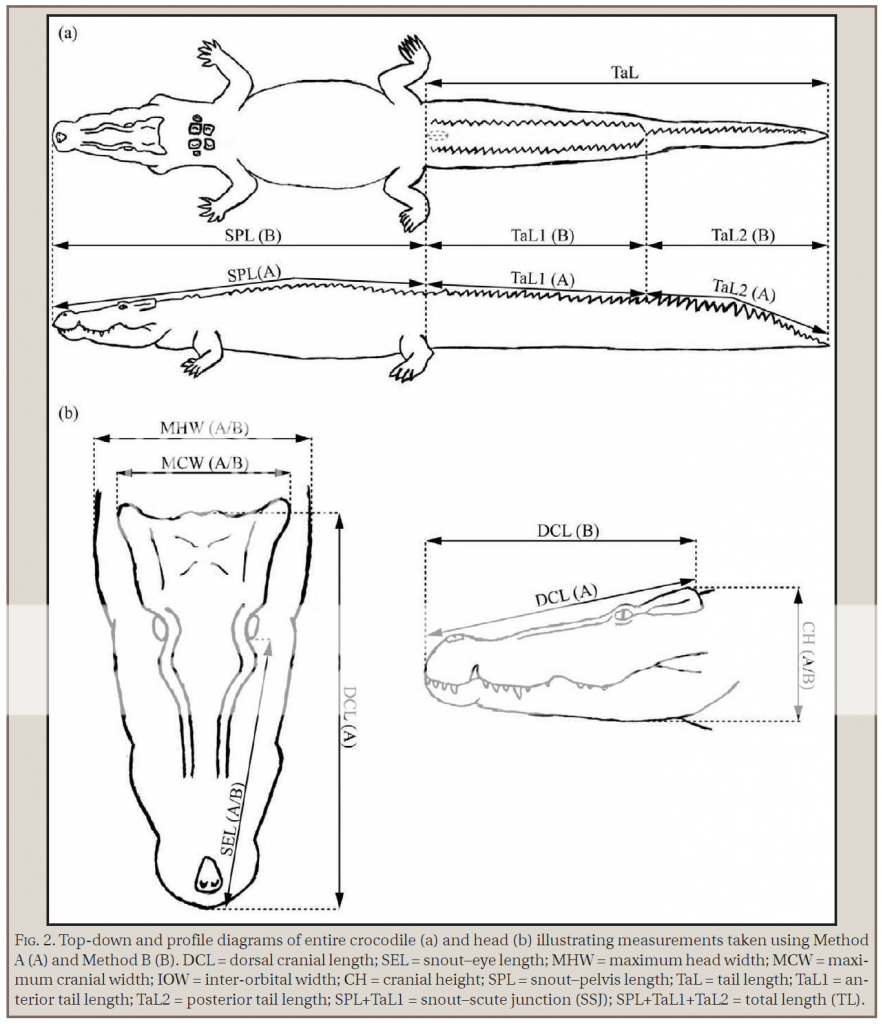|
|
Post by Vodmeister on Mar 26, 2014 12:42:22 GMT 5
Thanks for the citation! Here is the table from Erickson et al. (2012)  And here I link to the paper, It's open access. Here's the link to the whole issue of Herpetological Review that contains Britton et al. (2012) I have not gotten around to separate it from the journal. It starts on page 541 (this issue starts at page 509).
Mean Total Length = 344 cm Mean Body Mass = 272 kg Does this mean that a 23 feet specimen would weigh 2,302 kg, or 5,075 lb?  |
|
guategojira
Junior Member
  Now I become death, the destroyer of worlds!
Now I become death, the destroyer of worlds!
Posts: 160 
|
Post by guategojira on Mar 26, 2014 22:55:04 GMT 5
No, this average is a mixed data from 7 captive males and females specimens. As matter of fact, the average of only 272 kg would correspond more to a female than to a full grow male figure.
According with Gerald Wood (1978) the average male salt-water crocodile measure 4.26-4.87 m and scale 408-521 kg. This means that a normal full grow adult male would weight no less than 400 kg.
A specimen of 23 ft (7 m.) is not improbably but there is no hard evidence that they have ever existed. As matter of fact, I made a little investigation this morning and I am surprised of how many reliable and scientific records exist about this large crocodile in the WILD (compared with the ridiculously small sample for tiger, for example) but any of them surpass the 6 m, only Lolong reach that. In the weight is the same, none surpass the 600 kg, and again only Lolong do this. Check that all this records came from both Indian and Australian specimens.
Thanks to Blaze I discovered this new document of Dr Adam Britton of 2012 “Here be a Dragon: Exceptional Size in a Saltwater Crocodile (Crocodylus porosus) from the Philippines” and here is excellently described the body size and weight of Lolong. Here are the results:
“Using Method A, Lolong’s total length (TL) was 6.17 m (20.24 ft; Table 1), with a dorsal cranial length (DCL) of 700 mm (27.6 in). Ratio of DCL to TL was 1:8.8. Snout–pelvis length (SPL) was 2.85 m (9.35 ft). Therefore tail length (TaL) was 3.32 m (10.89 ft), with TaL to TL ratio of 1:1.9. Snout–scute junction (SSJ) was 4.98 m (16.34 ft), therefore we calculated anterior tail length (TaL1) as 2.13 m (6.99 ft) and posterior tail length (TaL2) as 1.19 m (3.90 ft). The ratio TaL2 to TaL is 1:2.8. Measurements using Method B are provided for comparison (Table 1). All measurements differed by less than 1% between Methods A and B except TL, which differed by 1.2%. Lolong’s net mass (accounting for the trailer weight) was 1075 kg (2370 lbs).”
Based on the few reliable records from scientists and the problem of the impossibility of review for all the records that Wood (1978) presents, I think that it will be safe to say that c.620 cm and 1075 kg is the maximum size recorded for a wild specimen of C. porosus, however the same document agrees that based on a giant skull in the Paris Museum, a length of up to 7 m is plausible. About the maximum weight, Wood (1978) report a gigantic specimen that alleged a length of 33 ft (10 m) and that was estimated at 3,048 kg (sic); the real length, based in its skull was estimated at “over 7.72 m”.
Apart from Lolong, the only other true giants with more or less reliable weights are a huge male shot in Sumatra that measured 503 cm in total length, weighed 589 kg and had a skull of 635 mm; the other was an Australian monster named “Big Gator” shot in 1964 that measured 609 cm in length and weighed 1,097 kg. Both figures from Wood (1978), but I don’t know if they have been investigated by other persons again. However, it seems at the end, very few accurately measured Salt-water crocodiles surpass the limit of 500 kg.
|
|
blaze
Paleo-artist   
Posts: 766
|
Post by blaze on Mar 27, 2014 1:54:21 GMT 5
VodmeisterThat average weight might be too high for a wild individual of that length, I think is more appropriate to scale from an animal closer in size like lolong, which will give a mass of 1.5 tonnes for an hypothetical 7m individual assuming it had the same proportions. guategojiraI may have been too quick by saying that 5m crocs will approach 700kg, it of course also depends on body condition, Erickson et al. (2004) says, for example, that captive alligators can be up to 25% heavier than wild ones of similar length but based on Woodward et al (1995) there can be great variation in the body condition of wild alligators, the one with the longest svl (2.26m) weighted 317kg while the heaviest one weighted 473kg with an svl of only 2.18m. This blog post by Whitaker World's Biggest Crocodiles mentions the supposed 10m crocodile having an skull only 71cm in DCL and estimating its total length using the 1:7 ratio will give a length of 4.7m but this ratio is known to understimate size in big specimens, in fact this measurement is slightly larger than that of Lolong so it might have been over 6m too, that post also lists 8 more skulls over 70cm long, all of them could come from 6m+ individuals. Lolong is indeed the largest scientifically measured alive wild individual but judging from those skulls, 6m crocs were not that rare, who knows how many are there lurking in the waters right now. Regarding weight, it seems they rarely get weighted in the wild, things go like on that Steve Irwin video, Lolong appears to have ben an special case because they were not going to release it and they wanted to weight it for Guinness, so we mostly only have captive individuals, Britton et al. (2012) mentions Yai, the hybrid, which I think died some years ago, as being 6m long and said to have been 1114kg and Cassius which has been measured at 5.5m long with a piece of its tail missing and supposedly weights 900kg but I don't know if they were actually weighted like lolong or the weights are estimated.
|
|
|
|
Post by Vodmeister on Mar 27, 2014 2:06:55 GMT 5
blazeI actually think that 1.5 tonnes for a healthy 23 feet individual might be too little. Remember, larger crocodiles add more bulk. Lolong was surprisingly skinny for his length. According to a study derived by Guate, the average saltie is about 4.5 meters and weighs 480 kg. If we scale that animal up to a 7.01 m (23 feet) specimen, he would be little over 1800 kg, or around 4000 pounds. This is very similar to the size of the accepted largest crocodile living in Bhitarkanika national park.
|
|
|
|
Post by Vodmeister on Mar 27, 2014 2:12:06 GMT 5
Regarding the actual purpose of this thread, I actually think that an average Bengal tiger (~200 kg) would do very well against an average 450-500 kg saltwater crocodile on land. The size disparity between the two isn't massive, and the feline is infinitely more agile on land.
|
|
blaze
Paleo-artist   
Posts: 766
|
Post by blaze on Mar 27, 2014 2:30:17 GMT 5
I think tail length might have something to do with the discrepancy, it might be possible that full grown salties have proportionally longer tails because if you go by SVL, Lolong is as robust as the heaviest scientifically measured wild American alligator, that weighted 473kg at 4.2m total length. But I have no evidence of this, SVL is little reported in the literature and I have only seen it used extensively on alligators for some reason.
I agree with what you and guategojira have said though, on land a tiger is match for a croc twice its size.
|
|
Fragillimus335
Member
   Sauropod fanatic, and dinosaur specialist
Sauropod fanatic, and dinosaur specialist
Posts: 573
|
Post by Fragillimus335 on Mar 27, 2014 2:51:47 GMT 5
Virtually no chance? Taking maximum vs maximum is really unfair, as the global population of saltwater crocodiles is a lot higher than that of bengal tigers. Taking average sizes won't be fair either (the reptile grows all it's life), so I would take similar sizes. Crocs don't grow their whole life, they just take a long time to reach maximum size. This is a common myth. |
|
guategojira
Junior Member
  Now I become death, the destroyer of worlds!
Now I become death, the destroyer of worlds!
Posts: 160 
|
Post by guategojira on Mar 27, 2014 3:48:52 GMT 5
This is Lolong in full view:  He doesn’t look skinny at all, for a wild specimen, at least. It is interesting to see that the figure or 617 cm came from the measurements along body curves, while the measurement “between two pegs” was of 609.5 cm! Check these images:   This shows me a whole different approach to these records. Although the discrepancy of the measurements in this case is not very large (7.5 cm, irrelevant for such a large animal), the measurements “over curves” in the field, from this same specimen, was of 6.4 m! This means that in not-ideal conditions, with curved ground like in the camp, the size of a large crocodile can be overestimated if measured in this way. This must be taken in count in the future comparisons, like in great cats. Wood (1978), for example, quotes clearly those specimens measured between pegs and those just along body curves. About the weight issue, I believe that a weight of 1,000 kg is already very exceptional. Larger specimens don’t necessarily mean heavier ones. In this case, Lolong was a true wild specimen and shows the first reliable maximum figure that a wild giant can get. The big “Yai” is clearly heavier (1,114 kg), but this was captive and hybrid. In other parts, like India, it seems that a weight of 600 kg is already exceptional, as the heaviest captive specimen there weighed "only" 575 kg. Here is an image of him (Jaws III) from March 24 of this year:  Note that the Facebook page from that place quotes a new weight of "over 650 kg" and a length of "over 16.5 ft (503 cm)" for him. I have write to this place today in order to see if this are "real" new measurements or only "educated estimations" (which will be appreciated, but irrelevant for scientific purposes). As far I know, the real measurements was of 485 cm - 575 kg a few years ago, but at this time, is completely plausible (if not mandatory) that at his 35 years old, he could be larger now. Finally, the skull measurements are really valuable and suggestive; however it will be important to take in count that these estimations are based on particularly large specimens that were selectively hunted trough the time. This means that for each of those large animals, several small ones were killed. I believe, in my humble opinion, that a “4.5 m long – 470 kg” male salt-water crocodile will be a good average specimen, a “5 m. 600 kg” a big one and “6.5 m >800 kg” a truly exceptional specimen. |
|
guategojira
Junior Member
  Now I become death, the destroyer of worlds!
Now I become death, the destroyer of worlds!
Posts: 160 
|
Post by guategojira on Mar 27, 2014 4:01:31 GMT 5
Virtually no chance? Taking maximum vs maximum is really unfair, as the global population of saltwater crocodiles is a lot higher than that of bengal tigers. Taking average sizes won't be fair either (the reptile grows all it's life), so I would take similar sizes. Crocs don't grow their whole life, they just take a long time to reach maximum size. This is a common myth. Great information and clarification. Did you know at which time a crocodile (of this species, if possible) reach the sexual maturity? At what age can we say that a croc is in his “prime”? Thanks and regards. |
|
|
|
Post by creature386 on Mar 27, 2014 19:10:10 GMT 5
Virtually no chance? Taking maximum vs maximum is really unfair, as the global population of saltwater crocodiles is a lot higher than that of bengal tigers. Taking average sizes won't be fair either (the reptile grows all it's life), so I would take similar sizes. Crocs don't grow their whole life, they just take a long time to reach maximum size. This is a common myth. No, they do grow their whole life, but after some time, growth becomes very slow. |
|
blaze
Paleo-artist   
Posts: 766
|
Post by blaze on Mar 27, 2014 22:04:03 GMT 5
There has not been any sufficiently big study of growth in the saltwater crocodile but determinate growth AFAIK has been corroborated in several alligatorids. In the wild American alligators from Louisiana, male alligators get to 3.5m long in the first 20 years of their lives and reach full size (3.9-4m) by around 40 years old (Chabreck and Joanen, 1979) while in a population from South Carolina males over 3.65m showed virtually none-existent growth (Woodward et al. 1995), Woodward et al suggest that growth in the American alligator is determinate based on this data and similar, unpublished of their own, later corroborated by osteohistological evidence ( Woodward et al., 2011) This is are some quotes from Woodward et al. (2011) |
|
|
|
Post by creature386 on Mar 27, 2014 22:06:40 GMT 5
Sorry, I forgot about that, I think you have shown this to me in the Karposuchus debate.
This is great news, as we now can use "adult" crocodiles, for average size calculations.
|
|
guategojira
Junior Member
  Now I become death, the destroyer of worlds!
Now I become death, the destroyer of worlds!
Posts: 160 
|
Post by guategojira on Mar 27, 2014 23:18:47 GMT 5
So, at the end, crocodiles don't grow all they life, they just grow more slowly than mammals.
There was a similar issue with the tiger in the old literature. Some authors believed that tiger lived up to 50 years and other, like Baikov, said that tigers grown through all they life.
Modern investigations on Amur tigers found that tigers continue growing up to its 4 years old. Latter, they just gain body mass until they reach about 12 years old. After that, they begin to loose condition. In the wild, the maximum longevity recorded for Amur tigers is of 12-14 years, but both records are unreliable as the female Pt-01 (Olga) was poached and the male Pt-20 (Dale) died drowned in a freezing pool. So, it is unclear how old they could get if this events were not caused they deaths.
For Bengal tigers, the oldest female recorded in Nepal was of 15.5 years old before been killed by another tiger. The oldest male in India was the famous B2 that reached the 14 years of life. At 2014, the oldest tiger alive is the famous Machali from Ranthambore that at its 17 years is still roaming the famous National Park.
Taking in count that tigers grown up to the 12 years old and that few tigers reach that age, a common person could say that they indeed they grow all they life, although scientifically, this is not the case.
|
|
|
|
Post by Godzillasaurus on Jun 5, 2014 1:47:01 GMT 5
In reply to blaze's table:
That measurement for the caniniform force is not that rosey people. For an approximately 600 pound croc, that is quite a bit of force driving them into the hide of a prey animal. The biting power in the rear of the mouth is obviously far greater (thus why the teeth in that region in mosts animals tend to be shorter and blunter than those farther forward).
I am bad at forces and stuff, but that value will only increase as the size of the animal does, and as such, the force driving the much longer and deadlier dentition (at least to larger terrestrial animals) would be higher with the maximum size for the salty.
|
|
|
|
Post by Ceratodromeus on Mar 18, 2016 0:30:15 GMT 5
I've found some accounts of interactions between tigers and crocodiles recently, i'll post them here -- do note that the species of crocodile (nor tiger) are mentioned, but these are relevant to the thread  from here from herethis one is more of an ambush, but there was a struggle involved, and suggests if the crocodile seizes the tiger this will likely be over.  from here from hereFrom crocoman |
|